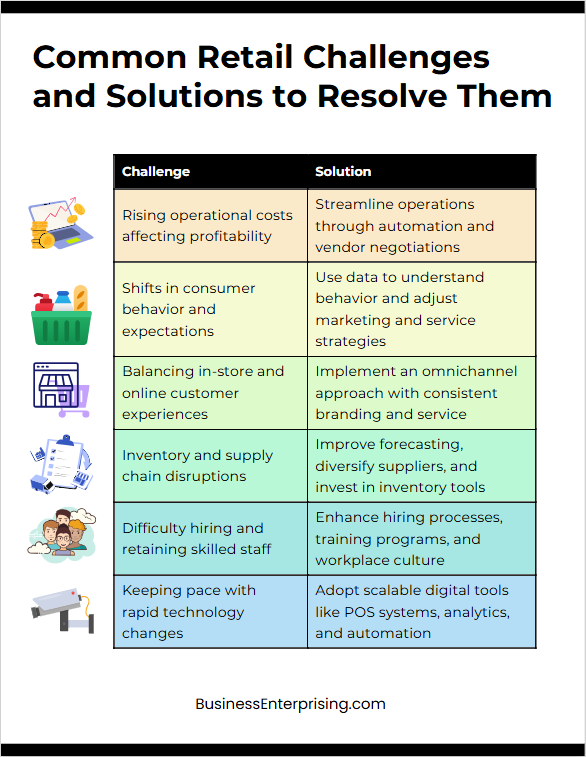
However, reacting alone is not enough. You also need to identify root causes and build repeatable solutions. Rising costs, shifting consumer habits, and supply disruptions can each affect your bottom line. Therefore, staying proactive helps you address problems before they grow. Additionally, learning from each challenge helps improve your overall operation.
Consumer expectations continue to evolve. Shoppers now want convenience, speed, and personalization across every channel. Therefore, aligning both online and in-store experiences is key. Additionally, using data and technology to track those changes gives you a competitive edge. Your team must also adjust quickly, so training and clear communication play an ongoing role.
Technology adds more tools—but also more complexity. New platforms can simplify your work, but they must integrate with your current systems. Therefore, choose tools that support long-term growth and everyday use. However, don’t let the pressure to modernize lead to rushed decisions. Assess each option carefully before making changes.
Retail business success depends on how well you respond to ongoing challenges. You need a balanced approach that allows for both flexibility and structure. By staying informed, investing wisely, and focusing on the customer, you can keep your business moving forward—no matter what comes next.
Managing Rising Operational Costs
Managing rising operational costs is a significant aspect of retail business challenges. Retailers face increasing expenses in areas such as labor, energy, and supply chain operations. These escalating costs can erode profit margins if not addressed effectively. However, by implementing strategic measures, you can mitigate these pressures without compromising quality or service.
One effective approach is to adopt automation technologies. Automating repetitive tasks, such as inventory tracking and order processing, can reduce labor costs and minimize errors. Leveraging technology like point-of-sale systems and inventory management software helps streamline operations and improve efficiency. Additionally, embracing automation in areas like queue management and self-service options can enhance customer experiences while reducing staffing needs.
Another strategy involves optimizing inventory management. Conducting a comprehensive assessment of your manufacturing process can identify inefficiencies and areas for cost reduction. Eliminating dead weight and automating certain aspects can lead to significant savings. Furthermore, implementing cost-effective marketing strategies, such as digital marketing channels, can reduce expenses associated with traditional advertising methods.
Outsourcing non-core business functions is also a viable option. By delegating tasks like IT support, payroll management, or customer service to external specialists, you can reduce labor costs while maintaining service quality. This approach allows your internal team to focus on core business activities, potentially leading to increased productivity and profitability.
Addressing rising operational costs requires a multifaceted approach. By leveraging automation, optimizing inventory, adopting cost-effective marketing, and outsourcing non-core functions, you can navigate these retail business challenges effectively. These strategies not only help control expenses but also maintain, or even enhance, the quality of service provided to your customers.
Adapting to Changing Consumer Behavior
Shifts in consumer behavior present significant retail business challenges, requiring retailers to adapt proactively. Understanding and responding to these changes are crucial for sustained success.
Today’s consumers are tech-savvy and expect seamless shopping experiences across online and offline platforms. They value convenience, personalized interactions, and swift service. To meet these expectations, retailers should integrate advanced technologies, such as smart mirrors and mobile apps, to enhance the in-store experience. For instance, Shoppers Stop employs smart mirrors, allowing customers to virtually try on products, blending digital convenience with physical shopping.
Additionally, the rise of e-commerce has led to the “Amazon Effect,” where consumers expect rapid delivery and competitive pricing. This phenomenon pressures traditional retailers to innovate continually. Implementing omnichannel strategies, like “click and collect” services, enables customers to order online and pick up in-store, merging the benefits of both shopping methods.
Sustainability has also become a priority for many shoppers. Consumers increasingly seek environmentally friendly products and practices. Retailers can address this demand by sourcing sustainable products and adopting eco-friendly operations, aligning with the growing trend toward conscious consumerism.
Personalization is another key factor. Customers appreciate tailored recommendations and communications that resonate with their preferences. Utilizing data analytics to understand shopping behaviors allows retailers to offer personalized experiences, fostering loyalty and satisfaction.
Adapting to changing consumer behavior involves embracing technology, implementing omnichannel strategies, committing to sustainability, and personalizing customer interactions. By proactively addressing these retail business challenges, retailers can thrive in an evolving marketplace.
Competing in an Omnichannel Environment
Balancing brick-and-mortar and e-commerce operations presents significant retail business challenges. Providing a consistent and seamless customer experience across all channels is essential. However, achieving this balance requires strategic planning and execution.
Integrating online and offline operations can be complex. Traditional retailers often struggle with pricing strategies in the digital landscape. Navigating these complexities is crucial for a successful omnichannel approach.
Consistency across channels is vital for customer satisfaction. Customers expect a seamless experience, whether shopping online or in-store. Aligning pricing, promotions, and inventory availability across platforms enhances trust and loyalty.
Employee training plays a significant role in overcoming omnichannel challenges. Without transparent communication, training, and team engagement, an omnichannel retailing project can fail.
Incorporating advanced technologies can further streamline operations. Artificial intelligence and machine learning can enhance personalized shopping experiences. These technologies also optimize inventory management, contributing to a more efficient omnichannel strategy.
Balancing brick-and-mortar and e-commerce operations requires addressing various retail business challenges. By focusing on integration, consistency, employee training, and technological advancements, retailers can provide a seamless customer experience across all channels.
Inventory and Supply Chain Disruptions
Managing inventory and supply chain disruptions ranks high among retail business challenges. Unforeseen events can halt the flow of goods, making it tough to maintain optimal stock levels. To navigate these uncertainties, you should adopt effective inventory management strategies. Integrated systems, like ERP and WMS solutions, provide real-time data, enhancing visibility and decision-making.
Accurate demand forecasting is another critical aspect. By analyzing historical sales data and market trends, you can predict consumer demand more precisely. This approach helps optimize inventory levels, reducing both stockouts and overstocks. Advanced technologies, such as AI and machine learning, further refine these forecasts, allowing you to adapt swiftly to market changes.
Diversifying your supplier base also mitigates risks associated with supply chain disruptions. Relying on multiple suppliers ensures that if one faces challenges, alternative sources can fulfill your needs. Building strong relationships with these suppliers fosters better communication, enabling proactive responses to potential issues.
Additionally, implementing a risk management plan is essential. Identifying potential disruptions and developing contingency strategies prepares your business to handle unforeseen challenges effectively. Regularly reviewing and updating this plan ensures its relevance in a constantly changing environment.
By focusing on these strategies, you can address inventory and supply chain disruptions effectively. This proactive approach not only safeguards your operations but also enhances customer satisfaction, keeping your business resilient in the face of retail business challenges.
Hiring and Retaining Skilled Staff
Addressing staffing shortages and employee turnover ranks high among retail business challenges. To tackle these issues, refining hiring processes is essential. Begin by crafting clear, compelling job descriptions that outline roles and expectations. This transparency attracts candidates who align with your needs. Additionally, leveraging technology, such as applicant tracking systems, can streamline recruitment, making it more efficient.
Once you’ve onboarded new employees, investing in comprehensive training programs is crucial. Proper training equips staff with the skills they need and fosters confidence in their roles. Moreover, offering continuous development opportunities keeps employees engaged and demonstrates your commitment to their growth. This approach not only enhances performance but also boosts retention.
Creating a positive workplace culture further aids in retaining skilled staff. Encourage open communication, recognize achievements, and provide support when needed. Such an environment fosters loyalty and reduces turnover. Additionally, offering flexible scheduling options can help employees balance work-life commitments, leading to higher job satisfaction.
Addressing these retail business challenges requires a multifaceted approach. By refining hiring practices, investing in training, and nurturing a supportive culture, you can attract and retain the talent necessary for your retail business to thrive.
Keeping Up with Technology and Digital Trends
Staying competitive in today’s retail landscape requires embracing advanced digital tools. One of the primary retail business challenges is integrating technology effectively. Modern point-of-sale (POS) systems have evolved beyond simple transaction processing. They now offer features like mobile payments and cloud integration, allowing real-time access to inventory and customer data. By adopting these systems, you can streamline operations and enhance customer experiences.
Additionally, artificial intelligence (AI) and machine learning are transforming retail. AI-driven personalization enables tailored marketing strategies and promotions, enhancing customer engagement. Automation technologies, such as AI-enabled security cameras, are also enhancing store security and operational efficiency. Implementing these technologies can lead to more efficient operations and improved customer satisfaction.
Mobile applications have become essential in modern retail. They facilitate seamless shopping experiences, from browsing to purchasing. Features like exclusive app-only offers further drive the shift toward mobile shopping. Integrating marketing automation tools can also enhance your outreach efforts. These tools allow for targeted campaigns based on customer behavior, leading to higher conversion rates. Embracing these digital trends is crucial for addressing retail business challenges and maintaining a competitive edge.
Conclusion
Running a retail business involves constant change. Consumer behavior, technology, and economic conditions shift quickly and often without warning. Therefore, staying flexible and responsive is key to managing retail business challenges. You need to identify problems early and act on them with smart, realistic solutions.
Additionally, focusing on your customers helps guide every decision. When you understand what they want and how they shop, you can adjust faster. Whether it’s investing in digital tools or streamlining supply chains, decisions grounded in customer needs tend to pay off. Therefore, listening to feedback and watching shopping trends should stay part of your routine.
However, solving operational issues takes more than short-term fixes. Hiring the right people, maintaining stock, and managing costs all require long-term planning. Training staff, improving internal systems, and using data tools can reduce stress on your daily operations. These efforts also build a stronger foundation for future growth.
Technology will continue to influence how you run your business. Therefore, exploring new digital solutions should remain a regular practice. From point-of-sale systems to customer data platforms, the right tools can make your work easier and more effective. However, not every tool is right for every business. Take time to assess what fits your needs best.
Retail business challenges will always exist. But with a thoughtful approach, you can overcome them. Stay consistent, listen to your team, and focus on clear actions. This combination helps you run a stable and competitive retail operation—one that adapts quickly and serves your customers well.



